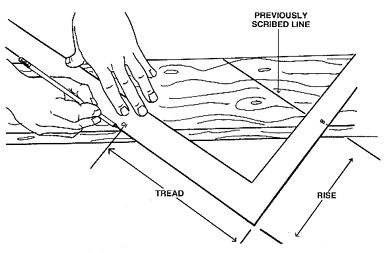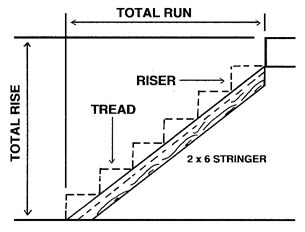Manufactured Housing
I decided to write this column about manufactured housing nearly one year ago. My research started at a Christmas party where I met the owner of the largest manufactured home dealership in Cincinnati. He really opened my eyes as to the dramatic changes and forces that were at work within the industry.
I toured several of his models just after Christmas. The quality of the traditional"single and double wides" impressed me. However, I was more impressed with the design possibilities of the modular homes. These structures are identical to just about any site built home you have ever seen. I can tell you that modular housing is going to be a major force in the housing industry as we proceed past the year 2000. You have to see it to believe it.
Production Problems
I built site built homes for nearly 15 years. I (as well as many of my past customers!) can tell you stories about frustrating delays, weather problems, magical sub-contractors who disappear without a trace, etc. All of these things cause site built housing to be an ordeal. Projects can last for months and months. In fact, the custom homes I built commonly took about 6 months to complete.
Add to this the fact that many custom home builders have little - if any - business management training. Most of us are carpenters who have risen through the ranks. This lack of training causes all sorts of problems!
Manufactured housing solves many if not all of these problems. The major manufactured home builders are huge corporations. They are run by shrewd business people who know how to schedule, negotiate great deals on materials, and manage labor forces. In other words, they get the job done! The result is that you can have a home built in ideal, climate controlled conditions in far less time than a site built home.
An Example
Here in the Cincinnati market you can be in a custom designed modular home sipping wine in less than 56 days! To put this number in perspective, it would generally take me about 30 days just to get a bid to you. Then I would have to get you into my schedule.
If you have your financing in place or a pre-qualification letter from a lending institution, you can order a modular home today here in Cincinnati. The factory can build it and deliver it in about 16 to 21 days. During that time, the local distributor is getting the permit and pouring the foundation. Once the house is delivered and set by crane, it only takes about 30 days to finish the home.
The quality will be better than any comparable priced home. There is a good chance that you will also save 10 to possibly 15 percent. These savings can be plowed into a larger home or possibly better fixtures.
Tons of Information
I could write a book about manufactured housing. There is so much to say. There are many outlets of information. Virtually every state has its own association of builders. To find out the Association in your state you have two choices. Contact a local manufactured home dealer. There is a good chance he is a member or can give you their number. If this doesn't work, start at the national level and ask them for the number of your local state association.
To get information about manufactured housing, I suggest you start with the following group:
Manufactured Housing Institute
2101 Wilson Boulevard
Suite 610
Arlington, Virginia 22201-3062
703-558-0400
www.mfghome.org
When you call or write, be sure to ask for any and all free information. They will gladly accommodate you. Ask for a list of all publications that they sell in their bookstore.
If you desire information about modular housing, then contact the following group. They will send you all sorts of stuff if you send them a check or money order for $3. Make the check out to Building Systems Councils of the NAHB. Send your request to:
Modular and Panel Homes
Building Systems Council NAHB
1201 15th Street, NW
Washington, DC 20005
www.nahb.com
Seeing is Believing
If you are getting ready to build a new home, I URGE you to visit every manufactured home dealer in your area. Ask to see all of their products or those that interest you. Be sure to ask for addresses of modular homes that are completed. Drive by those to see for yourself the possibilities of a home built in a factory. I am quite sure that you will seriously consider a manufactured home after seeing one!
Manufactured Housing Industry Statistics - Facts
The Big Boys
Who are the major players in the manufactured housing market? First let me say that as of August of 1997 there were 88 corporations building manufactured homes of one type or another across America. These companies had a combined total of 322 factories producing product. The number of corporations was down from a total of 98 a year before. I suspect this could have been the result of growth by acquisition - not necessarily company failures. In other words, the big companies were possibly buying up smaller companies.
During 1996 the entire manufactured housing industry constructed and shipped 363,411 homes. 89 percent of these homes were built by just 25 companies. The Top 10 companies produced 258,613 houses or 71 percent of the total. Here is a listing of the Top Ten producers for 1996:
|
Fleetwood Enterprises
Champion Enterprises
Oakwood Homes
Clayton Homes
Skyline Corporation
Cavalier Homes
Palm Harbor Homes
Horton Homes
Belmont Homes
Southern Energy Homes
|
67,313
59,650
26,212
24,676
18,791
14,529
13,394
12,006
11,103
10,939
|
Square Foot Costs
You can get much more space for less money. That is a fact. If you just look at the average sales price of all lengths and widths of manufactured houses for 1996, you get a square foot cost of $27.83. Modular housing will be more because of the complexity of the house and system. However, the modules will almost always cost less than site built housing. The average square foot cost for site built housing for all of America for 1996 was $58.66. That is a big difference! Statistics courtesy of Manufactured Housing Institute
Manufactured Housing Companies
The following manufacturers of manufactured housing are all member of the Manufactured Housing Institute. There are other manufacturers out there, but for one reason or another, they decided not to be part of the huge national organization. Each of the manufacturers may make different types of housing. Some may only do one type. For example, Patriot Homes was doing more full blown manufactured housing until recently. It has seen its modular division produce 85% of its gross sales in the past 18 months alone! You can see that modular housing is the wave of the future.
To find out about manufactured or modular housing in your area I want you to do several things. First, I doubt that you will ever be able to buy DIRECTLY from a manufacturer. They almost always deal with local distributors. There are many, many reasons for this. You should first call the manufacturers below that build or distributes in your state or region. If they don't have a TOLL FREE number, ask the operator as soon as you connect. Often they have TOLL FREE numbers you can use to call back. Once connected, ask if they build the type of home you want. If so, ask for literature and a list of all local distributors.
You should also open your Yellow Pages. Unfortunately, the dealers in your area will probably be found in "Mobile Homes". This probably makes them cringe, but that is the name most people associate them with. This will change in time. Call your local dealers and ask what they carry or build. Ask for sub-division locations or addresses of completed homes. Drive by and see what you think. Be SURE to tour a model. You won't believe how nice they are.
Regions
Region 1 Maine, Vermont, New Hampshire, Massachusetts, Connecticut, and Rhode Island
Region 2 New York, Pennsylvania, and New Jersey
Region 3 Maryland, Delaware, West Virginia, Virginia, North & South Carolina, Georgia, and Florida
Region 4 Michigan, Wisconsin, Illinois, Indiana, and Ohio
Region 5 Mississippi, Alabama, Tennessee, and Kentucky
Region 6 Minnesota, Iowa, Missouri, Kansas, Nebraska, and South and North Dakota
Region 7 Texas, Oklahoma, Arkansas, and Louisiana
Region 8 Montana, Idaho, Wyoming, Colorado, Utah, Nevada, Arizona, and New Mexico
Region 9 Washington, Alaska, Oregon, California, and Hawaii
Manufacturers
American Family Homes Regions: 4, 6 & 7
Anderson, Missouri 417-845-3311
American Homestar Regions: 4, 6 & 7
Arlington, Texas 817-695-0100
Buccaneer Homes Regions: 3, 4, 5, 6 & 7
Hamilton, Alabama 800-264-2822
Burlington Homes of Maine Regions: 1 & 2
Oxford, Maine 207-539-4406
Cavalier Homes, Inc. Regions: 1 through 7
Addison, Alabama 205-747-1575
Champion Home Builders Regions: ALL
Auburn Hills, Michigan 248-340-9090
Chief Industries Regions: 6, 7 & 8
Aurora, Nebraska 402-694-5250
Clayton Homes Regions: 4, 6 & 7
Knoxville, Tennessee 423-970-7200
Commodore Group Regions: 1 through 7
Goshen, Indiana 219-533-7100
Crestline Homes Regions: 3 & 5
Laurinburg, North Carolina 910-276-0195
Fleetwood Enterprises Regions: ALL
Riverside, California 909-351-3838
Fleming Homes Regions: 3, 4, 5 & 6
Flemingsburg, Kentucky 606-849-4119
Franklin Homes Regions: 3, 4, 5, 6 & 7
Russelville, Alabama 205-332-4510
Golden West Homes Regions: 6, 8 & 9
Santa Ana, California 800-888-1382
Guerdon Industries Regions: 5, 6, 7, 8 & 9
Lake Oswego, Oregon 503-624-6400
Heartland Homes Regions: 3 & 5
Henderson, North Carolina 919-492-1151
Hi-Tech Housing Regions: 2, 4 & 6
Bristol, Indiana 219-848-5593
Keiser Industries Regions: 1
Oxford, Maine 207-539-8883
Kit Manufacturing Regions: 7 & 9
Caldwell, Idaho 208-459-1575
Mid-America Homes Regions: 4, 5, 6 & 7
Benton, Kentucky 502-527-5006
Mobile Home Estates Regions: 1 through 7
Bryan, Ohio 419-636-4511
Moduline International Regions: 8 & 9
Lacey, Washington 206-491-1130
New Era Building Regions: 1, 2, 3, 4 & 5
Strattanville, Pennsylvania 814-764-5581
Oakwood Homes Regions: 3 through 9
Greensboro, North Carolina 910-664-2400
Patriot Homes Regions: 2 through 8
Elkhart, Indiana 219-293-6507
R-Anell Custom Homes Regions: 3 & 5
Denver, North Carolina 704-483-5511
Redman Homes Regions: ALL
Dallas, Texas 972-353-3600
Rochester Homes Regions: 4
Rochester, Indiana 219-223-4321
Schult Homes Regions: ALL
Middlebury, Indiana 219-825-5881
Skyline Corporation Regions: ALL
Elkhart, Indiana 219-294-6521
Sphere Industries Regions: 3
Hallandale, Florida 305-456-2200
Victorian Homes Regions: 2, 4, 5 & 6
Middlebury, Indiana 219-825-5841
Virginia Homes Regions: 1, 2 & 3
Boydton, Virginia 804-738-6107
Wick Building Systems Regions: 4, 6 & 8
Mazomanie, Wisconsin 608-795-4281
Column B206

